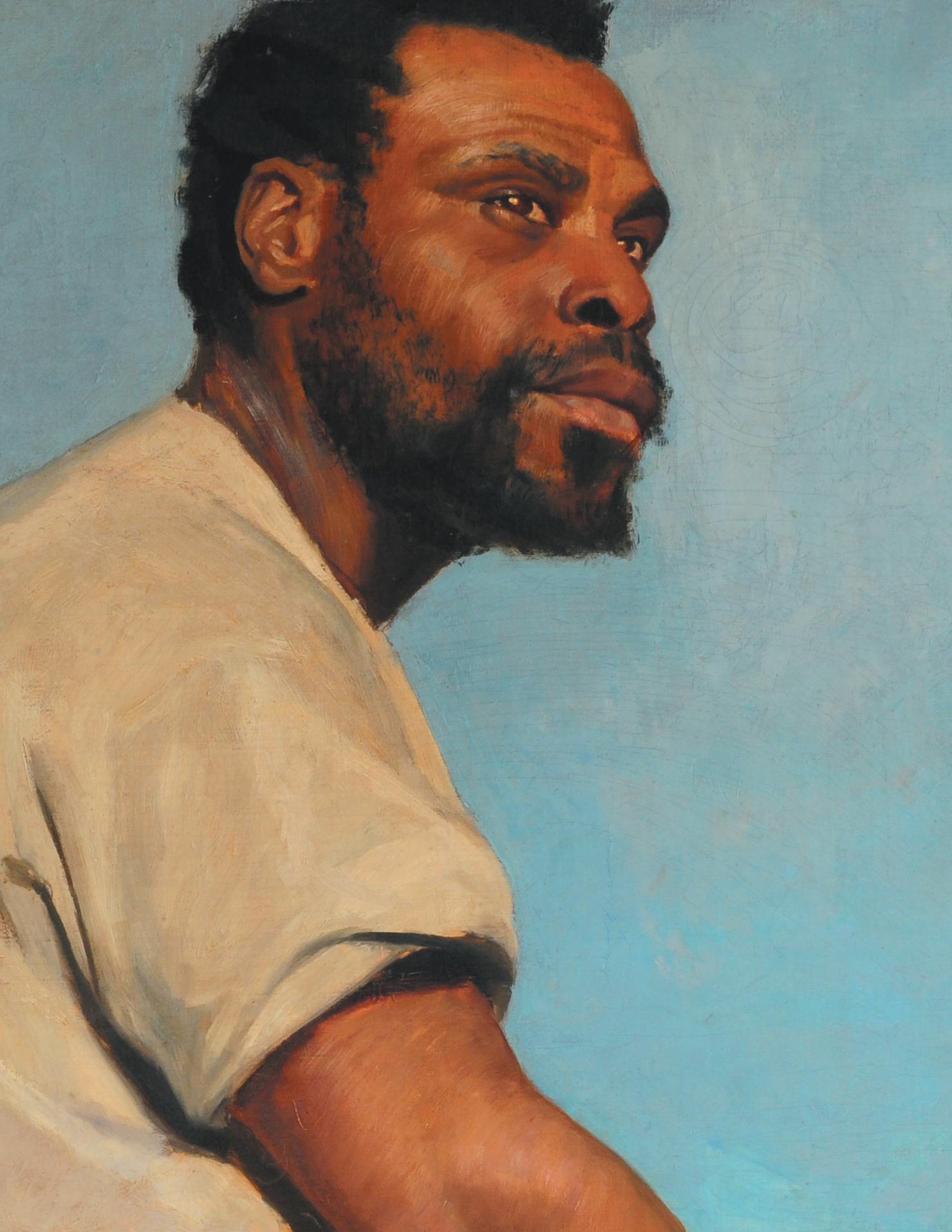
Pierre LouisAlexandre
“The Most Depicted BlackPersoninPre-ModernArt”


Pierre LouisAlexandre
“The Most Depicted BlackPersoninPre-ModernArt”
©MatsWerner2021and 2025
Translated by B.J. Woodstein
Cover: “Negro Petterson”,oil painting by KarinBergöö-Larsson(original titleNegernPetterson)
Unless otherwisestated, allphotosand illustrationsare from theauthor’sprivate archive. Thereweresomephotographers we searched forbut were unable to find, andif youknowmorepleasecontact thepublisher.
Publisher: BoD·Books on Demand,Östermalmstorg1,114 42 Stockholm, Sweden,bod@bod.se
Printer: LibriPlureos GmbH,Friedensallee 273, 22763Hamburg,Germany
ISBN:978-91-8114-605-9

The Black man leansagainst adraped-over base.Heholds up hisleftleg with his claspedhands.Heisdressed in apairofstriped,tight shorts,withayellowshawl as abelt, andawidewhite shirt, itssleeves rolled up.His dreamy andslightlyabsent-minded gaze is directed at somethingoutside of theframe.His shortbeard andslightlydisheveledhair reinforcethe impression of security andstability.
Hisentirefigure radiates potentialpower,dormant strength. Thelight over himisthatof thesouthernsun.Still,it’sjustanillusion. In fact,the manisfromFrenchGuiana, andhe happened to endupincoldSweden, whereheworks adockerand brings in extramoney during thewinterasamodel at Konstakademien (the RoyalSwedish AcademyofFineArts). Thesouthernsunlightwas conjured up by Academystudent KarinBergööinher powerful portrait of “Negro Petterson”1,which is what he wascalledatthe ArtAcademy amongthe students andteachers…andperhaps by himself.
In fact,his name wasPierreLouis Alexandre, butIlearned that much later. Let’sstart from thebeginning.
My father Einarhad,duringhis civilservice as ayoung courtofappeals notary at the Östernärke judicial district in Örebro,alargercityinmid-Swedenacouplehours west of Stockholm, made connectionswithpeopleatthe surroundingmills andmanors. Among others,thisincludedthe ironmonger PerBergöö andhis companyinHallsberg.Per Bergöö’s parentsAdolf andHilda hadalready passed away by that time.Adolf hadstarted work on thebeautiful home that FerdinandBobergdesignedtobeboththe family home andthe ironmonger;today,thisbuildingiscalledBergööska Huset(theBergööHouse). However,
1Notefromthe author andthe translator: This bookaimstomakevisible apreviouslyunseenand importantaspect of Blackhistory in Sweden.Languageis, however, achallenge here becausethe wordspeopleusedatthattimein Sweden andinEnglish-speakingcountries arenot necessarilythe termsacceptedtoday,which are, in turn,likelyto shiftagain in thefuture. Theauthor, inspired by JamesBaldwin’s book IAmNot Your Negro,feels that “Negro”isthe most appropriatewordto usewhentranslating thetermasemployedin, forexample,the titles of artworks.Inother contexts,wehavechosen“Black”. Thegoalof this wastotry to utilizelanguagethatisclose to what wouldhavebeen employed at thetimewhenPierreLouiseAlexandre wasworking as amodel andlivinginStockholm,but also to avoid offending modern readerstoday.Wetrust that youwillunderstandthatthiswas done with thebestofintentions.
it wasnot finishedbeforeAdolf died andhis widowpreferred to stay in thefamily’sapartment in Stockholmratherthantomoveintothishouse.Instead,itwas theirson Perwho movedinwithhis family andtookoverthe management of thecompany.Per’s sister Karin hadbythattime, afterher training at theAcademy in Stockholm, marriedthe artist Carl Larssonand they hadmoved to AdolfBergöö’s farm LillaHyttnäs in Sundborn in Dalarna.
Afterhis civilservice,Dad went on to work at Knut Littorin’s lawfirm in Stockholmin 1922,where he washead-hunted even before he finishedhis studies. He remained therefor twelve years, includingasa partnerfrom1930forward.Dad broughtwithhim anumber of clientswho he gottoknowduringhis time in Örebro,including PerBergöö. Bergöö and hisironcompany became importantclients forthe lawfirm,and oneyearKnutLittorin rented thesummerresidence at Spadarvet, Karinand Carl Larsson’sfarmhouse next to the couple’s ownhome, LillaHyttnäs.

KarinBergöö’spaintinghas enteredEinar Werner’s room in hisparents’homeonTorsgatan.
PerBergöö hadason of thesamename, who, with more or less success, triedhis hand at animal breeding in theStockholm area. This didn’t work outand in theend he wasforced into bankruptcy.Myfatherhelped himwithsomelegal matters. Readingbetween thelines in thedocuments,I cansee that theyoung Perwas notconsideredtobea very successful businessman. Amongother things,I read in amemofrom1927where Littorin wrote to Dadthat, “This deal should be concludedwithout theinvolvement of youngBergöö, whoislikea redflag to abullfor thecreditor, andwho,incidentally, does notunderstand anything aboutthis.”Nor didthe youngBergööalwaysseemtohaveany moneytopay Dadwith, so apaintingbyhis Aunt Karinthathehad received from hisfatherservedas paymentinstead. Thepaintinginquestion, whichdepicted“theNegro Petterson”,was one of KarinBergöö’sworks from hertimeasa studentatthe RoyalSwedish AcademyofFine Arts,which sheattended1877-1882. Thefactthatthe painting endedupwithyoung Per insteadofremaining with hisfatherwas perhapsdue to thefactthathealwayscalledthe painting “the damned Blackman”. It hadbeenhungbyKarin,togetherwithanother piece from hertimeatthe Academycalled“TheViking”,inthe staircaseofthe Bergöö House. I’mgladDad accepted theoffer of apaintinginstead of monetary payment. Thepainting washungaround1926-27 in hisroominhis parents’ home at Torsgatan2 in Stockholm untilhemarried andmoved to KaplansbackenonKungsholmen. There, “Negro Petterson” became anoted family member whoalwaysmadeastrongimpressiononour guests. Many friendsand acquaintancesof both my parentsand us siblings foundthat“theNegro Petterson” wastheir lastingmemoryof ourhome.
Many yearslater,whenthe arthistorian Caroline Falkenberg held aseriesoflectures in connection with alarge exhibition at theLiljevalchs konsthallgallery,“They Went to Paris”,about thefirstgenerationof youngfemaleartists whowentabroadtostudy,she used “Negro Petterson” as an exampleofKarin Bergöö’s artistry.
Formorethan50years,hehungonmywall. Ihavealwaysbeendeeplymoved by the portrait andfascinatedbythe proudBlack man. Butwho washe? ABlack maninStockholm at theend of the19th centurymusthaveattracted attention! AndIwonderedwhere allthe otherworks of artwiththe same model, whichmusthavebeencreated,were.
Searchingthrough newspapersources offered no information. Thereweredescriptions of aBlack minstrel singer,but even Karl XV’s Blackvalet left no noticeable traces in the dailypress.Inother words, aman whoworkedinthe port wasnot likely to be considered to be of interest,whether he wasBlack or not.
In 2012,Cecilia Sylvan Henriksson andPatrick Gibson publishedthe book Svarti Sverige (Black in Sweden), whichprovidesahistoricaloverviewofseveral of theBlack people who livedinSwedenovertime. In fact,there were many more than expected.But it is clearthat thosewho came here,one wayoranother,generally endedupeitheratthe royalcourt or in themilitary, wheretheyservedasmounted drummers at thefront of military orchestras, whichwas considered afeather in thecap of theorchestra andthe regiment.
“Blåman” (literally,“Blue Man”)isthe oldest knowntermfor BlackpeopleinSweden. It wasemployedasfar back as theVikingera. Thetermwas also used as thenameofanarea (about thesizeofa city block) in Stockholmand as thetitle of asongbythe songwriter Olle Adolphson. In the16th century, theterm“morian”(Moor)madeits entrance;itwas originally aLatin word for“NorthAfrican”. In thelate19th century, “mor/mohr” (Moor) became themostcommonwordand wasalsooften thetitle forpaintings that depicted Blackmen during this time.

KarlXV’s“pipe cleaner” and protégéJohnToxon Panzio.
”The Most Depicted Black Person in Pre-Modern Art”
“PoorPedro stomponthe quay freeze cold Pedrocome home womanhang body in wood pile”.
This curious rhymehas arousedthe curiosit yofgenerations of Stockholmers.But wheredid it come from?Was thereanactualevent like theone describedinthe rhyme?
Yes, therewas.AuthorMatsWerner hasspent yearsresearching this rhymeand thestory behinditinorder to find out who“poor Pedro” was. Ar tist KarinBergöö(latermarried to painter Carl Larsson) paintedanimage of “Pedro”, whobecameknownas“NegroPetterson”, and Bergöö’s painting hung in Mats Werner ’s childhoodhome,which is what incitedhis interest in themodel’s stor y.
Pierre LouisAlexandre, as it turned outhewas ac tually named, wasbornand raised in Cayenne in French Guianaasthe childof aslave woman. He endedupincoldSweden in the1870s,and beganworking as amodel forthe studentsatthe RoyalSwedish AcademyofFineArts. Anders Zorn,Alber tEngström, JohnBauer,Oscar Björk, andother well-regardedartists areamong thosewho depic tedhim.
Butwho washeand howdid he suppor thimself otherwise? Wheredid he live? Wheredid he come from andwhy washeinSweden? Didhehavea spouse andchildren? When andhow didhedie?
In this book ,you canreadMatsWerner ’s research into Alexandre’slife, andget answersto allthose questions.Inaddition,you cansee allthe currentlyknownartworksthatdepic thim. Alexandrehad afascinating life andwas theinspirationfor many beautifulpaintings, drawings, andsculptures. Here, Mats Werner ’s detectiveworkiscarefully laid outsothatthe Blackmodel cantakecentrestage.

Mats Werner wasbornin1943and raised in Stockholm. He is awriterand arthistorian andalsoa retiredentrepreneurininternational advertisingand marketing.Hespent many yearsasa municipal politician,commentator, andchoir singer. In addition, he haswritten regularlyinlocal andtrade press, andcontributed to several books. Hisown books includeDen störstaoch vackraste, aboutthe S/SNorrtelje ship,and LasseWerner– en lyckligskit, aboutjazzmusicianand composer LasseWerner. Mats livesin Mariefred, Sweden.
